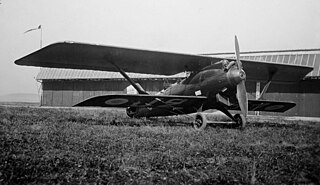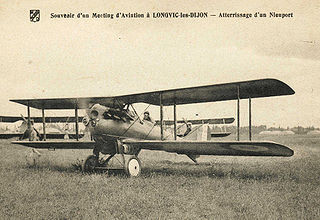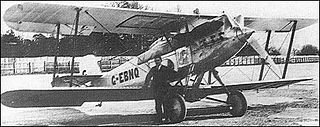Related Research Articles

The Amiot 143M was a late 1930s French medium bomber designed to meet 1928 specifications for a bomber capable of day/night bombing, long-range reconnaissance and bomber escort.

The Bristol F.2 Fighter is a British First World War two-seat biplane fighter and reconnaissance aircraft developed by Frank Barnwell at the Bristol Aeroplane Company. It is often simply called the Bristol Fighter, "Brisfit" or "Biff".

The Breguet 19 was a sesquiplane bomber and reconnaissance aircraft which was also used for long-distance flights and was designed by the French Breguet company and produced from 1924.

The Sopwith 5F.1 Dolphin was a British fighter aircraft manufactured by the Sopwith Aviation Company. It was used by the Royal Flying Corps and its successor, the Royal Air Force, during the First World War. The Dolphin entered service on the Western Front in early 1918 and proved to be a formidable fighter. The aircraft was not retained in the postwar inventory and was retired shortly after the war.

The Blériot-SPAD S.61 was a French fighter aircraft developed in 1923. Designed by André Herbemont, the S.61 was a conventional biplane, abandoning the swept upper wing used by Herbemont in several previous designs. The prototype S.61 was evaluated by the French Air Force alongside the S.51 as a potential new fighter, but like its stablemate, was rejected. The Polish Air Force was impressed enough to order 250, as well as purchase licences for local production. The Romanian Air Force also ordered 100 aircraft. About 30 were built in Poland, by the CWL.

The Vickers Vendace was a 1920s British trainer aircraft. It was originally designed as a floatplane trainer for the Royal Air Force.

The Vickers F.B.26 Vampire was a British single-seat pusher biplane fighter built by Vickers during the First World War.

The Nieuport-Delage NiD.29 was a French single-seat biplane fighter designed and built by Nieuport-Delage for the French Air Force.

The Levasseur PL.5 was a carrier-based fighter produced in France in the late 1920s, in response to the 1924 AMBC.2 specification issued by the Service Technique de l'Aéronautique (STAé). It was a conventional, single-bay sesquiplane that carried a crew of two in tandem, open cockpits. Like other Levasseur naval designs of the day, it incorporated several safety features in case of ditching at sea. Apart from small floats attached directly to the undersides of the lower wing, the main units of the fixed, tail-skid undercarriage could be jettisoned in flight, and the underside of the fuselage was given a boat-like shape and made watertight.

The Nieuport-Delage NiD 42 was a fighter aircraft built in France in the early 1920s, the first in a family of designs that would form the backbone of the French fighter force over the next decade.

The Vickers Type 123 was a 1920s British single-seat biplane fighter designed and built by Vickers Limited as a private venture. The only Type 123 was later modified into the Type 141 but, not winning any orders, it was scrapped in 1930.
The Sopwith 2FR.2 Bulldog was a prototype British two-seat fighter of the First World War. A single-engined biplane, the Bulldog was a fighter/reconnaissance aircraft intended to replace the Bristol F.2 Fighter, but was unsuccessful, with no replacement for the Bristol Fighter being purchased.

The Vickers E.F.B.7 was a prototype British fighter aircraft of the First World War. A twin-engined biplane, the E.F.B.7 was unsuccessful, only one being built.

The Royal Aircraft Factory N.E.1 was a prototype British Night fighter of the First World War. A single-engined pusher biplane, it was a development of the Royal Aircraft Factory's earlier F.E.9 fighter, but was not successful, only six being built.

The Vickers F.B.16 was a British single-seat fighter aircraft of the First World War. It was originally designed to be powered by an experimental radial engine, development of which was abandoned. When re-engined with more powerful and reliable water-cooled V-8 engines, the F.B.16 demonstrated good performance, but only a few prototypes were built, the type not entering service.

The Vickers F.B.25 was a British two-seat night fighter prototype of World War I designed to attack enemy airships. Completed in 1917, it failed in its official flight tests that year and no order for production resulted.

The Nieuport-Delage NiD 120 series was a series of French single-seat parasol monoplane fighter aircraft of the 1930s. It was built in a number of versions, fitted with various types of engines, with six aircraft designated NiD 123 being sold to Peru.

P.Z.L. P.8 was a fighter designed by Ing. Zygmunt Puławski and constructed by P.Z.L. from 1930.
The Wibault Wib 1, Wib C1 or, later, Wib 1 C1 was a French World War I single seat, single engine fighter aircraft prototype. Flown near the end of the war, it was not selected for production.

The Wibault 12 Sirocco or Wib 12 Sirocco was a two-seat, parasol wing fighter aircraft designed and built in France in the 1920s. Three fighter prototypes were completed, one for the RAF and two Army co-operation variants. There was no series production.
References
- Andrews, C.F. and E.B. Morgan. Vickers Aircraft since 1908. London:Putnam, 1988. ISBN 0-85177-815-1.
- Bruce, J.M. British Aeroplanes 1914–18. London:Putnam, 1957.
- Bruce, J. M. War Planes of the First World War:Volume Three Fighters. London:Macdonald, 1969. ISBN 0-356-01490-8.
- Mason, Francis K. The British Fighter since 1912. Annapolis, Maryland, USA:Naval Institute Press, 1992. ISBN 1-55750-082-7.
- ""Milestones":The Vickers Machines". Flight , 12 June 1919. pp. 760–769.